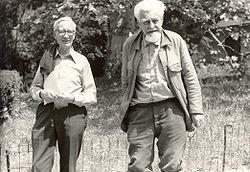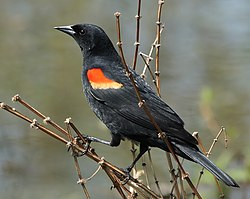Animal Behavior/Scope
The Aims and Scope of Animal Behavior
[edit | edit source]
The study of the behavior of animals is very fortunate that students, who enter this field with a wish to learn more about its scientific approaches, are already intrigued by their own observations. Invariably, beginning students come in equipped with detailed descriptions of behavioral eccentricities of their own pets, wildlife, or smaller siblings. The main challenge is for us to understand the fundamental nature of the scientific approach that must be used to study behavior more formally. Only a rigorous experimental characterization of behavioral phenomena will yield common generalities on how and why animals do what they do - rather than providing a simple catalog of anecdotes. The study of behavior thus critically depends on our ability to phrase our general inquiry as a series of questions that can be answered with standard scientific approaches, that are amenable to experimental probes, and which lead to an explicit and unambiguous interpretation of its results.
Niko Tinbergen's legacy as a exceptionally gifted experimentalist include the phrasing of four different types of questions that can be asked of any animal behavior,[1] now simply referred to as Tinbergen's 4 Aims. This paper summarizes the multidisciplinary approach that had guided the emergence of the field of Ethology since its early roots at the beginning of the 20th century.[2] They group broadly into questions about proximate and ultimate explanations. Proximate explanations are closest to the event that is to be explained, while higher, ultimate explanations instead focus on the deeper reasons for why something happened.
Proximate Explanations
[edit | edit source]Neural, Endocrine, and Genetic Mechanisms
[edit | edit source]Causes that explain how a behavior is elicited and coordinated. What are the anatomical or physiological mechanisms that underlie the behavior? The behavior is present because the nervous system makes it happen. It includes a search for the impact of genetic components, physiological mechanisms, environmental conditions needed, and hormones on behavior.
Examples:
Ontogeny, Development
[edit | edit source]How does the behavior develop and change during the lifespan of a single individual? The behavior is present because the individual developed an ability to do it this way.
Examples:
Ultimate Explanations
[edit | edit source]Survival Value
[edit | edit source]Explanations are phrased as ultimate causes that explain why a behavior has evolved. Selection ought to favor individuals with behaviors that help it increase its reproductive success. The behavior is present because the individual inherited them from parents who were historically successful with this behavior.. This includes a search for functional significance or adaptiveness of behavior.
Phylogeny, Evolution
[edit | edit source]What were the macroevolutionary patterns of changes that lead to the behavior today?
Phylogeny is the study of evolutionary relatedness among groups of organisms as It treats a species as a group of lineage-connected individuals over time. It attempts to historically characterize the branching processes in which breeding populations have changed over time. The ethologist's view holds that behavioral characteristics, which receive at least a partial genetic contribution, and can be viewed in a phylogenetic perspective like any other morphological trait. The behavior is present because the individual is an offspring from ancestors that had the behavior.
Examples:
Example - Territoriality in Red-winged Blackbirds
[edit | edit source]
 | |
| Problems listening to this file? See media help. | |
Male red-winged blackbirds are conspicuous and familiar birds throughout most of North America, where they commonly occupy and defend perches near sources of water. Aggressive while defending a territory, they will attack much larger animals, such as ravens, hawks, or humans who encroach upon their territories.[3] In the northern US, male red-winged blackbirds return from their wintering grounds in early March. In rather stunning song-spread display they flaunt their prominent red epaulets, they lower and spread their tails, puff out their feathers, issuing their distinctive Cong-a-lee! call. According to Tinbergen's 4 Aims our interests as to "Why" they would show such a distinctive type of territorial advertising can be organized in a number of different ways.
Aim 1: Proximate Mechanisms
[edit | edit source]We may ask questions on the particular mechanics that cause the behavior via its underlying neural, endocrine, and genetic mechanisms - i.e., the behavior's proximate causation. Our interests would focus on whether the male is responding to a particular stimulus such as the approach of a rival, what neural mechanisms aid in the detection of key stimuli, what neural circuits, hormonal triggers, or gene products are necessary for the behavior's expression, or how seasonal changes in day length are able to control them?
The vocal organ of birds, the syrinx, is located at the base of the blackbird's trachea. Sound is produced when air flowing through it causes the syringeal walls to vibrate. Muscles modulate the sound shape by changing the tension of the membranes and the bronchial openings.[4] Centers for song production pathways include the High vocal center (HVC); robust nucleus of archistriatum (RA); and the tracheosyringeal part of the hypoglossal nucleus (nXIIts).[5][6] Both pathways show sexual dimorphism, with the male producing song most of the time.[7] Androgens are believed to play a key role in the expression of male song behaviors as it exhibits a strong correlation with seasonal testosterone profiles.[8][9] Song is enhanced with testosterone injections and ceases following adult castration. Injections of testosterone induce growth of the HVC and thereby even produce song in female birds, which otherwise would not sing.
Aim 2: Development, Learning
[edit | edit source]We could also query in what way the territorial display emerges in development. What role does maturation play? To what degree does the behavior depend on learning processes and tutors? What neural substrates are involved in its acquisition?
The song of red-winged blackbird males, like that of many other song birds, is learned. A comparison of hatchlings, which were either deprived of normal song altogether or simply presented with its recording, demonstrated that individuals readily learned their song from conspecifics in the vicinity. Far from a pure cultural transmission of song dialects, however, innate predispositions played an important role. Some individuals were able to learn complex repertoires with minimal stimulation[10] while others were quite reluctant to develop elaborate, species-specific calls. Some remain faithful to their tutors while others improvised readily and invented new versions.[11] The neural signals that subserve vocal learning center on the anterior forebrain pathway with magnocellular nucleus of the anterior neostriatum (LMAN), Area X, and the Dorsolateral Medial thalamus (DLM).[12]
Aim 3: Functional Significance
[edit | edit source]Alternatively, we may be interested to know what function this particular territorial display serves. If selection favors individuals with a behavior that is beneficial to the bearer's reproductive success, what are the precise benefits bestowed to that individual and its parents? What defines this behavior as successful in evolutionary terms? What factors are turned up by a search for the functional significance or adaptiveness of this behavior?
When red-winged blackbirds were surgically muted, the loss of song affected their ability to defend the territory.[13] Males were captured and replaced by an auditory display of the individual's recorded song[14] to examine whether the broadcasts alone would be sufficient to defend the territories.
Aim 4: Evolution
[edit | edit source]Does the red-winged blackbird perform its territorial display because its ancestors did it in a similar way? Is it the only one within its clade that has this display? What were the precise patterns of change throughout the evolutionary lineage that result in the behavior today? How does the red-winged blackbird's display compare to that of other blackbirds?
Most members of the red-winged blackbird's evolutionary lineage communicate with simple call notes, suggesting that its specific call features may have been inherited from an ancestral taxon.[15]
References
[edit | edit source]- ↑ Tinbergen N. 1963. On the aims and methods of ethology. Z. Tierpsychol. 20: 410-433
- ↑ Lorenz KZ. 1937. Biologische Fragestellungen in der Tierpsychologie (in English: Biological Questions in Animal Psychology). Z. Tierpsychol. 1: 24-32
- ↑ "Chicago locals beware the birds". news.bbc.co.uk (BBC News). 2008-06-24. http://news.bbc.co.uk/1/hi/world/americas/7470871.stm.
- ↑ Larsen ON and Goller F, 2002. Direct observation of syringeal muscle function in songbirds and a parrot. J. Exp. Biol. 205: 25-35
- ↑ Brainard MS and AJ Doupe (2000). "Auditory feedback in learning and maintenance of vocal behavior". Nature Rev. Neurosci. 1: 31–40. doi:10.1038/35036205.
- ↑ Carew TJ. (2000). Behavioral Neurobiology: The Cellular Organization of Natural Behavior. Sinauer Associates, Inc. ISBN 978-0878930920.
- ↑ Bottjer SW, Halsema EA and AP Arnold (1984). "Forebrain lesions disrupt development but not maintenance of song in passerine birds". Science. 224: 901–903. doi:10.1126/science.6719123. PMID 6719123.
- ↑ Nottebohm F, Nottebohm ME, Crane LA, Wingfield JC. 1987. Seasonal changes in gonadal hormone levels of adult male canaries and their relation to song. Behav Neural Biol. 47(2):197-211.
- ↑ Marler P, Peters S & Wingfield JC. 1987. Correlations between song acquisition, song production, and plasma levels of testosterone and estradiol in sparrows. J. Neurobiol. 18, 531−548
- ↑ Peters S, Marler P and Nowicki S. 1992. Song sparrows learn from limited exposure to song models. Condor 94: 1016-1019
- ↑ Marler P, Mundinger P, Waser MS and Lutjen A. 1972. Effects of acoustical stimulation and deprivation on song development in red-winged blackbirds (Agelaius phoeniceus). Animal Behaviour 20: 586-606
- ↑ Troyer TD and Bottjer SW. 2001. Birdsong: models and mechanisms. Current Opinion in Neurobiology 11: 721-726
- ↑ Peeke F and Smith D
- ↑ Yasukawa K, Bick EI, Wagman DW and Marler P. 1982. Playback and speaker-occupation experiments on song-based neighbor, stranger, and self discrimination in male Red-winged Blackbirds. Behavioral Ecology and Sociobiology 10: 211-215
- ↑ Irwin RE. 1996. The phylogenetic content of avian courtship display and song evolution. in: Phylogenies and the comparative method in Animal Behavior. (Martins EP ed.) Oxford University Press, USA
